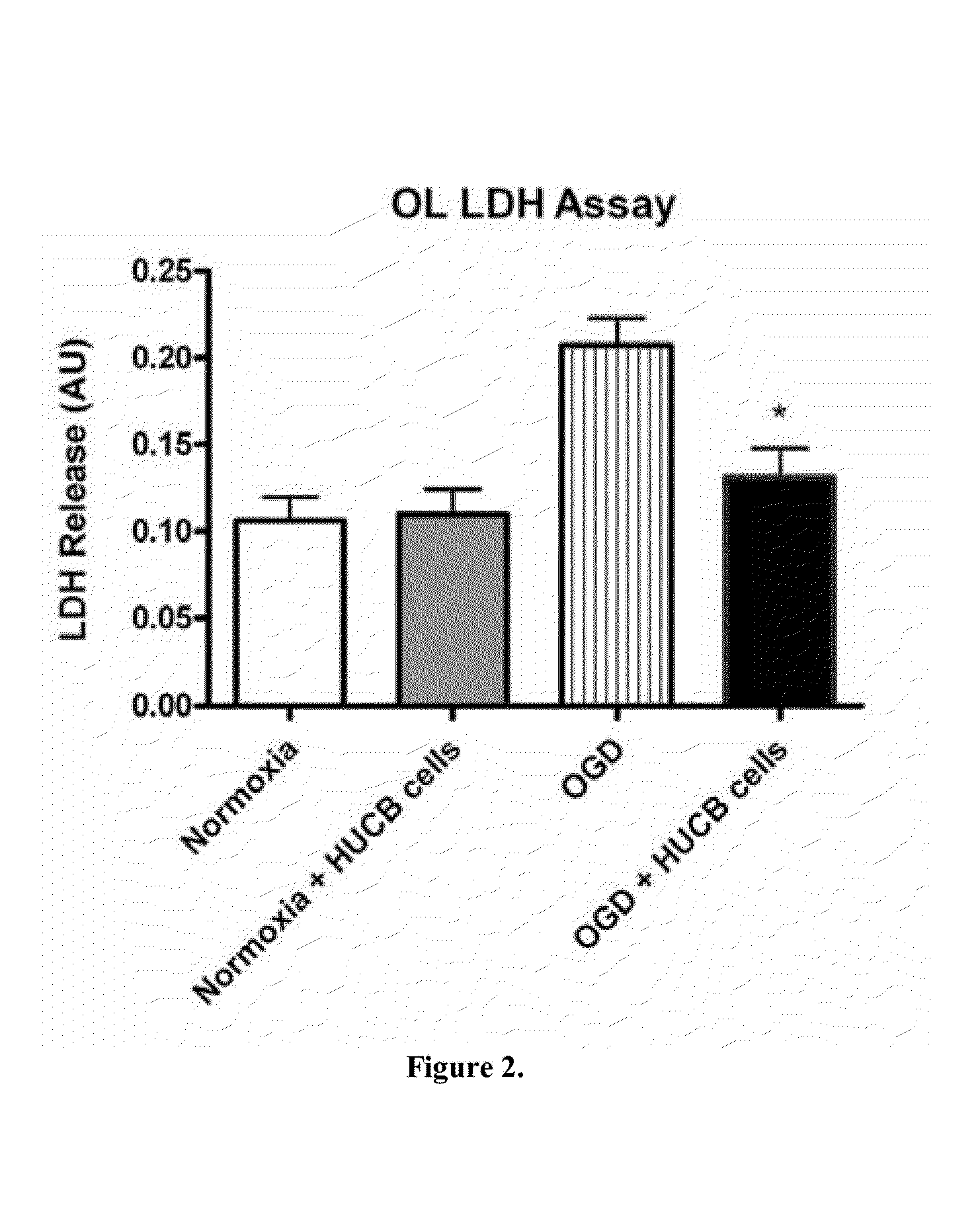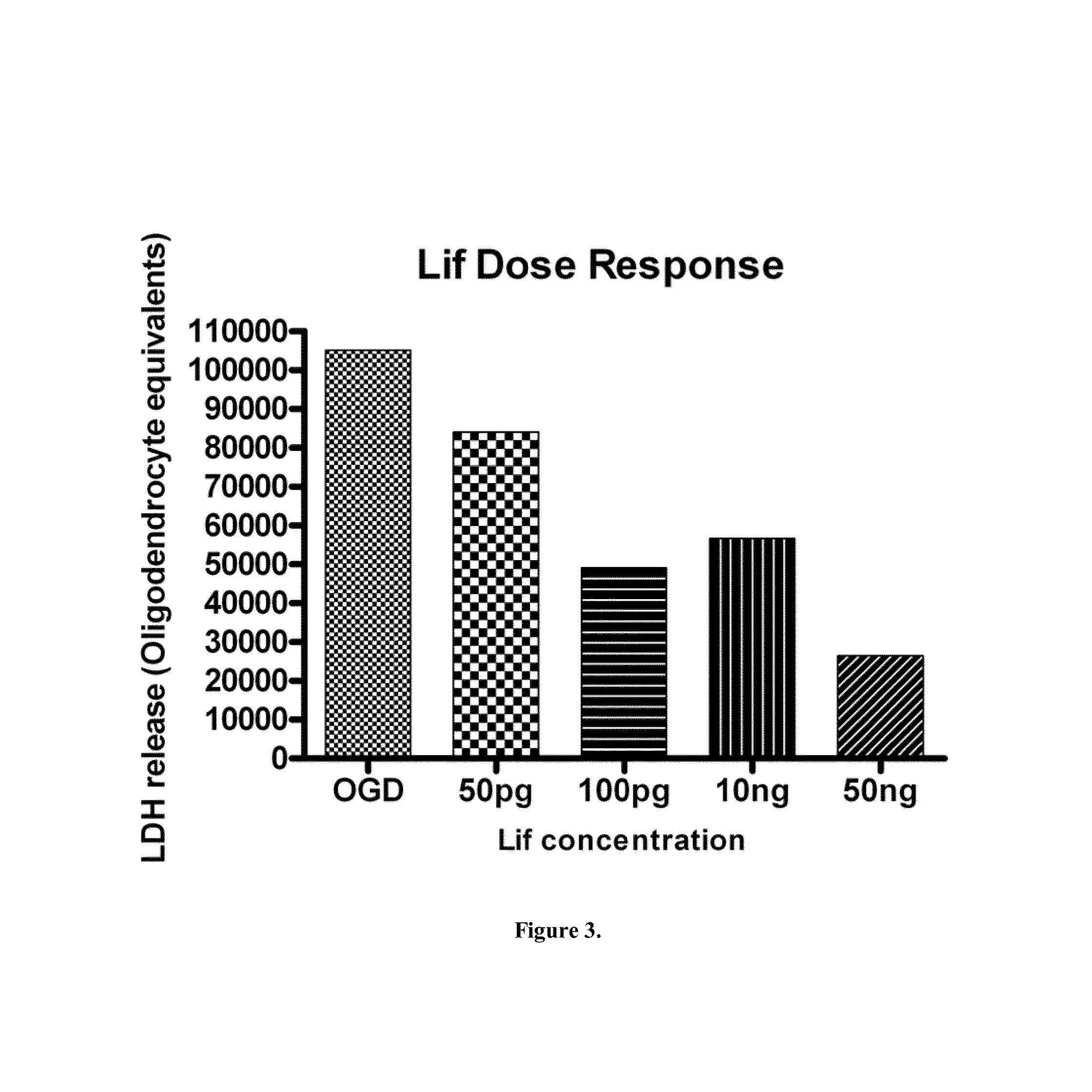Use of endogenous antioxidant proteins in the treatment of stroke
a technology of antioxidant proteins and endogenous antioxidant proteins, which is applied in the field of stroke treatment, can solve the problems of inability to fully understand the precise pathways involved in hucb cell-mediated ol survival, selective vulnerability of oligodendrocytes and microglia to combined hypoxia and hypoglycemia injury, etc., to enhance the replacement of membrane lipids, improve the expression of anti-oxidant proteins, and improve the survival and repair of cells
- Summary
- Abstract
- Description
- Claims
- Application Information
AI Technical Summary
Benefits of technology
Problems solved by technology
Method used
Image
Examples
example 1
[0058]Mixed glial cultures were prepared using postnatal day 3 rat pups. The pups were decapitated, brains removed, and meninges dissected away. Rat cortices were dissociated in a solution of 0.25% trypsin / 2.21 mM EDTA, triturated, and pelleted. The pellet was re-suspended in DMEM (Mediatech, Manassas, Va.) supplemented with 2.5% fetal bovine serum, 10% horse serum, and 1% antibiotic / antimycotic (DMEM+). Trypan Blue exclusion was used to assess cell viability. Cells were seeded (1.5×107) into poly-lysine-treated 75 cm2 tissue culture flasks. Media was changed with fresh DMEM+ the following day and cultures were incubated for 8 days at 37° C. (Gottschall, P. E., et al., 1995. Increased production of gelatinase B (matrix metalloproteinase-9) and interleukin-6 by activated rat microglia in culture. J Neurosci Res. 42, 335-42).
[0059]Oligodendrocytes were purified from the mixed glial cultures by mechanically shaking the cultures for 1 hr to separate microglial cells from the OL / astrocyt...
example 2
[0077]Male Sprague-Dawley rats, weighing 300-350 g, were used subjected to middle carotid artery occlusion (MCAO) (Butler, T. L., et al., 2002. Neurodegeneration in the rat hippocampus and striatum after middle cerebral artery occlusion. Brain Res. 929, 252-60; Hall, A. A., et al., 2009. Human umbilical cord blood cells directly suppress ischemic oligodendrocyte cell death. J Neurosci Res. 87, 333-41; Vendrame, M., et al., 2004. Infusion of human umbilical cord blood cells in a rat model of stroke dose-dependently rescues behavioral deficits and reduces infarct volume. Stroke. 35, 2390-5) to test HUCB cell effects on oligodendrocytes. Prior to MCAO surgery, animals were anesthetized with 5% isofluorane / O2 in an induction chamber. Rats were treated prophylactically with Ketoprofen (10 mg / kg s.c.), atropine (0.25 mg / kg s.c.) and Baytril (20 mg / kg i.m.) in accordance with IACUC guidelines. Ketoprofen injections were continued 3 days post-MCAO to minimize pain and discomfort. A constant...
example 3
[0089]The present study employed both in vitro and in vivo approaches to test the efficacy of HUCB cells in reducing OL cell death and white matter injury, respectively. LDH levels in media from OL cultures co-incubated with HUCB cells during OGD were reduced relative to OL-only cultures. As previously reported (Newcomb, J. D., et al., 2006. Timing of cord blood treatment after experimental stroke determines therapeutic efficacy. Cell Transplant. 15, 213-23; Vendrame, M., et al., 2004. Infusion of human umbilical cord blood cells in a rat model of stroke dose-dependently rescues behavioral deficits and reduces infarct volume. Stroke. 35, 2390-5), HUCB cell treatment 48 hrs post-stroke reduced infarct volume. Separate experiments showed that O4 immunoreactivity increased in the ipsilateral external capsule of rats treated with HUCB cells 48 hrs after MCAO. Upregulation of this OL marker was consistent with the previous report (Hall, A. A., et al., 2009. Human umbilical cord blood cel...
PUM
| Property | Measurement | Unit |
|---|---|---|
| Time | aaaaa | aaaaa |
| Cell death | aaaaa | aaaaa |
Abstract
Description
Claims
Application Information
 Login to View More
Login to View More - R&D
- Intellectual Property
- Life Sciences
- Materials
- Tech Scout
- Unparalleled Data Quality
- Higher Quality Content
- 60% Fewer Hallucinations
Browse by: Latest US Patents, China's latest patents, Technical Efficacy Thesaurus, Application Domain, Technology Topic, Popular Technical Reports.
© 2025 PatSnap. All rights reserved.Legal|Privacy policy|Modern Slavery Act Transparency Statement|Sitemap|About US| Contact US: help@patsnap.com



